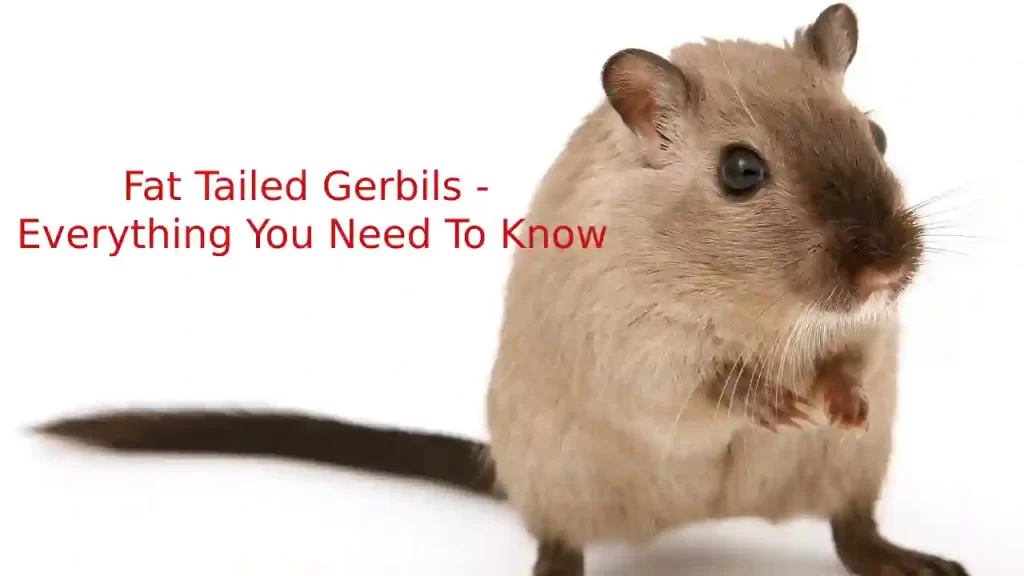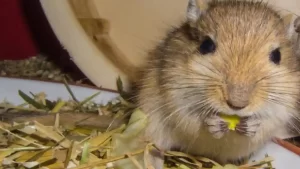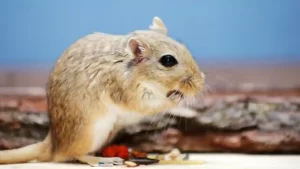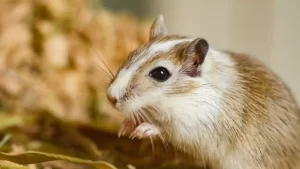Are you thinking about buying a fat-tailed gerbil? They are adorable little creatures, but there are some things you should know before bringing one home.
This blog post will tell you all about these critters, from their personality to their care needs.
So if you’re thinking of adding a fat tailed gerbil to your family, read on!
Fat-Tailed Gerbil Origin
The fat-tailed gerbil is a native of North Africa and the Middle East. It was introduced to Europe in the early 20th century, and to the United States in the late 20th century. The name “fat-tailed” refers to the animal’s large, fatty tail, which can make up almost half of its body weight.
The fat-tailed gerbil is a small rodent with a body length of 5 to 7 inches (12.5 to 17.5 cm) and a tail length of 3 to 4 inches (7.5 to 10 cm). The animal has thick fur that is brown or grey in color, with lighter underparts. Males and females are similar in appearance, although males tend to be slightly larger than females.
The fat-tailed gerbil is a social animal that lives in small colonies of up to 20 individuals. The animals are active during the day and night, and they use their tails for balance when they run and jump.
Fat-tailed gerbils are omnivorous, meaning they eat both plants and animals. Their diet consists of seeds, fruits, vegetables, insects, and small mammals.
In the wild, fat-tailed gerbils typically live for 3 to 4 years. In captivity, however, they can live for up to 8 years.
The fat-tailed gerbil is not considered to be an endangered species. However, fat-tailed gerbils are kept as a pet, and they are also used in medical research. (1)
Characteristics Of A Fat-Tailed Gerbil
The physical characteristics of a Fat-Tailed Gerbil are as follows: they have a short, stocky body; their head is small and round with large, protruding eyes; and they have a short, stubby tail.
They are usually brown or grey in color with a light underside. Fat-Tailed Gerbils typically weigh between 50 and 70 grams.
Ecology and Habitat
Fat-tailed gerbils are found in the deserts of Africa, Asia, and the Middle East. They prefer arid habitats with loose sand or dirt where they can dig burrows to escape the heat of the day.
These nocturnal animals are relatively solitary, coming together only to mate.
Diet
Fat-tailed gerbils are omnivorous, eating both plant and animal matter.
Their diet consists mostly of seeds, insects, and small vertebrates. They will also consume sand to help with digestion.
Reproduction
Fat-tailed gerbils reproduce sexually, with males and females coming together only to mate. After a gestation period of about 24 days, the female will give birth to a litter of 2-8 young.
The young are born blind and deaf, but they grow quickly and are independent after just a few weeks.
Predators
The main predators of fat-tailed gerbils are snakes, lizards, and birds of prey. They use their burrows as a refuge from these predators, as well as from the hot desert sun.
Conservation Status
Fat-tailed gerbils are not considered to be threatened at this time and have a stable population. They are sometimes kept as pets, but they are not commonly seen in captivity.
Fat Tailed Gerbil Lifespan
The average lifespan of a fat-tailed gerbil is around 3-5 years, although some may live up to 8 years. However, the majority will not make it to their 5th birthday due to predation, disease or malnutrition.
In the wild, these animals are constantly at risk from predators such as snakes, birds of prey and mammals such as weasels and foxes. They also have to contend with harsh weather conditions and a lack of food during times of drought.
In captivity, fat-tailed gerbils can be protected from all these threats but they are still susceptible to health problems such as obesity, diabetes and heart disease. These ailments are often the result of poor diet and lack of exercise and can dramatically reduce the lifespan of these animals.
To help your fat-tailed gerbil live a long and healthy life, it is important to give them a nutritious diet and plenty of opportunities to exercise. A good quality gerbil mix should be the foundation of their diet and should be supplemented with fresh vegetables and fruits. Gerbils also love to chew so providing them with wooden toys and chews will help keep their teeth in good condition.
Fat Tailed Gerbil Care & Info
The Fat-tailed Gerbil is a small rodent that originates from the African countries of Senegal, Mauritania, Mali, and Niger.
These animals have become popular pets in recent years due to their docile nature and low maintenance care requirements.
Fat-tailed Gerbils are also known by many other names including African Fat-tailed Gerbils, Desert Hamsters, and Wax Mice.
As their name suggests, Fat-tailed Gerbils have a noticeably large and rounded rear end.
This feature is caused by an accumulation of fat deposits in their tail which can make up over half of their total body weight.
In the wild, these stored fats help the Fat-tailed Gerbil survive long periods without food or water.
Fat-tailed Gerbils are generally brown in color with a light-colored belly. They have large ears and eyes, and their tails are covered in short, fine hairs.
Males and females look similar to one another, but males tend to be slightly larger than females.
These small rodents are very active and love to play. They are also very curious by nature and will often explore their surroundings.
Fat-tailed Gerbils are generally gentle animals that do well around children and other pets.
Fat-tailed Gerbils are easy to care for and make great pets for first-time pet owners.
They require a cage that is at least 24 inches long, 12 inches wide, and 12 inches high.
The cage should be equipped with a water bottle, food dish, exercise wheel, and hiding places. (Here are our recommended list of best cages for gerbils)
Fat-tailed Gerbils are omnivorous and their diet should consist of a variety of foods including pellets, seeds, fruits, vegetables, and live insects.
A good quality pellet food will provide your Fat-tailed Gerbil with the majority of the nutrients they need. Seeds and nuts should be given in moderation as they are high in fat.
Fresh fruits and vegetables should be given daily and can include items such as apples, bananas, broccoli, carrots, celery, and spinach.
Live insects can be given as a treat and can include crickets and mealworms.
Are fat-tailed gerbils social?
Yes, fat-tailed gerbils are social creatures. They live in groups in the wild and enjoy the company of other gerbils in captivity.
When kept as pets, fat-tailed gerbils should be housed with at least one other gerbil.
If you have the space, it is best to house them in pairs or small groups. They are not aggressive and get along well with other gerbils. (2)
Fat-Tailed Gerbils Nutritional Requirements
Fat-tailed gerbils are native to the Sahara Desert and other dry regions of North Africa. They have evolved to live in these arid conditions by developing several adaptations, one of which is their large and fatty tails.
This fat reserve provides them with the energy they need to survive in their harsh environment and also helps them to regulate their body temperature.
In captivity, fat-tailed gerbils still require a diet that meets their nutritional needs and takes into account their natural dietary habits.
A good quality pelleted food designed specifically for gerbils is a good place to start, but it should be augmented with fresh vegetables and fruits, as well as a small amount of meat or insects.
As with all animals, it is important to provide fat-tailed gerbils with fresh, clean water at all times. A water bottle attached to the side of the cage is the best way to do this.
Frequently Asked Questions (FAQs)
Do fat-tailed gerbils make good pets?
Fat-tailed gerbils, also known as pocket mice, are small rodents that originate from the deserts of Africa and Asia. They get their name from their distinctive fat tails, which help them store energy and water in arid environments.
Fat-tailed gerbils have become popular pets in recent years due to their docile nature and cute appearance.
These small rodents make great pets for first-time pet owners and families with children. They are relatively easy to care for and can be trained to use a litter box.
Fat-tailed gerbils are active and playful, but they also enjoy spending time snuggling with their owner.
If you’re looking for a low-maintenance pet that will bring some fun and excitement to your life, a fat-tailed gerbil might be the perfect choice for you!
How much do fat-tailed gerbils cost?
Fat-tailed gerbils typically cost between $10 and $20. Some breeders may charge more for particularly rare or unusual colourations.
Prices may also vary depending on whether you are buying a pet-quality or show-quality gerbil. Ultimately, the best way to get a fat-tailed gerbil is to find a reputable breeder who can provide you with a healthy and well-adjusted animal.
Summary
Fat tailed gerbils make great pets for people who have a lot of time to spend caring for them. They are active and playful and love to explore their surroundings.
- Fat-tailed gerbils need a large cage with plenty of toys and climbing areas. They also need a diet that is high in protein and low in sugar.
- If you can provide your fat tailed gerbil with the right care, they will make wonderful companions.





